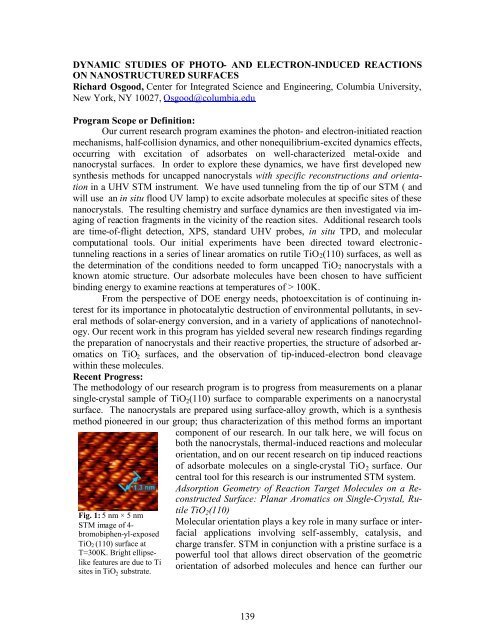Eighth Condensed Phase and Interfacial Molecular Science (CPIMS)
Eighth Condensed Phase and Interfacial Molecular Science (CPIMS)
Eighth Condensed Phase and Interfacial Molecular Science (CPIMS)
Create successful ePaper yourself
Turn your PDF publications into a flip-book with our unique Google optimized e-Paper software.
DYNAMIC STUDIES OF PHOTO- AND ELECTRON-INDUCED REACTIONS<br />
ON NANOSTRUCTURED SURFACES<br />
Richard Osgood, Center for Integrated <strong>Science</strong> <strong>and</strong> Engineering, Columbia University,<br />
New York, NY 10027, Osgood@columbia.edu<br />
Program Scope or Definition:<br />
Our current research program examines the photon- <strong>and</strong> electron-initiated reaction<br />
mechanisms, half-collision dynamics, <strong>and</strong> other nonequilibrium-excited dynamics effects,<br />
occurring with excitation of adsorbates on well-characterized metal-oxide <strong>and</strong><br />
nanocrystal surfaces. In order to explore these dynamics, we have first developed new<br />
synthesis methods for uncapped nanocrystals with specific reconstructions <strong>and</strong> orientation<br />
in a UHV STM instrument. We have used tunneling from the tip of our STM ( <strong>and</strong><br />
will use an in situ flood UV lamp) to excite adsorbate molecules at specific sites of these<br />
nanocrystals. The resulting chemistry <strong>and</strong> surface dynamics are then investigated via imaging<br />
of reaction fragments in the vicinity of the reaction sites. Additional research tools<br />
are time-of-flight detection, XPS, st<strong>and</strong>ard UHV probes, in situ TPD, <strong>and</strong> molecular<br />
computational tools. Our initial experiments have been directed toward electronictunneling<br />
reactions in a series of linear aromatics on rutile TiO2(110) surfaces, as well as<br />
the determination of the conditions needed to form uncapped TiO2 nanocrystals with a<br />
known atomic structure. Our adsorbate molecules have been chosen to have sufficient<br />
binding energy to examine reactions at temperatures of > 100K.<br />
From the perspective of DOE energy needs, photoexcitation is of continuing interest<br />
for its importance in photocatalytic destruction of environmental pollutants, in several<br />
methods of solar-energy conversion, <strong>and</strong> in a variety of applications of nanotechnology.<br />
Our recent work in this program has yielded several new research findings regarding<br />
the preparation of nanocrystals <strong>and</strong> their reactive properties, the structure of adsorbed aromatics<br />
on TiO2 surfaces, <strong>and</strong> the observation of tip-induced-electron bond cleavage<br />
within these molecules.<br />
Recent Progress:<br />
The methodology of our research program is to progress from measurements on a planar<br />
single-crystal sample of TiO2(110) surface to comparable experiments on a nanocrystal<br />
surface. The nanocrystals are prepared using surface-alloy growth, which is a synthesis<br />
method pioneered in our group; thus characterization of this method forms an important<br />
component of our research. In our talk here, we will focus on<br />
both the nanocrystals, thermal-induced reactions <strong>and</strong> molecular<br />
orientation, <strong>and</strong> on our recent research on tip induced reactions<br />
of adsorbate molecules on a single-crystal TiO2 surface. Our<br />
central tool for this research is our instrumented STM system.<br />
Adsorption Geometry of Reaction Target Molecules on a Reconstructed<br />
Surface: Planar Aromatics on Single-Crystal, Ru-<br />
Fig. 1: 5 nm × 5 nm<br />
STM image of 4bromobiphen-yl-exposed<br />
TiO2 (110) surface at<br />
T=300K. Bright ellipselike<br />
features are due to Ti<br />
sites in TiO 2 substrate.<br />
tile TiO2(110)<br />
<strong>Molecular</strong> orientation plays a key role in many surface or interfacial<br />
applications involving self-assembly, catalysis, <strong>and</strong><br />
charge transfer. STM in conjunction with a pristine surface is a<br />
powerful tool that allows direct observation of the geometric<br />
orientation of adsorbed molecules <strong>and</strong> hence can further our<br />
139
















